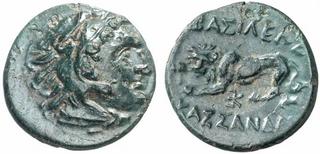Thessaloniki
 Thessaloniki (; ), also known as Thessalonica (), Saloniki, Salonika, or Salonica (), is the second-largest city in Greece, with slightly over one million inhabitants in its metropolitan area, and the capital of the geographic region of Macedonia, the administrative region of Central Macedonia and the Decentralized Administration of Macedonia and Thrace. It is also known in Greek as "" (), literally "the co-capital", a reference to its historical status as the () or "co-reigning" city of the Byzantine Empire alongside Constantinople.
Thessaloniki (; ), also known as Thessalonica (), Saloniki, Salonika, or Salonica (), is the second-largest city in Greece, with slightly over one million inhabitants in its metropolitan area, and the capital of the geographic region of Macedonia, the administrative region of Central Macedonia and the Decentralized Administration of Macedonia and Thrace. It is also known in Greek as "" (), literally "the co-capital", a reference to its historical status as the () or "co-reigning" city of the Byzantine Empire alongside Constantinople.Thessaloniki is located on the Thermaic Gulf, at the northwest corner of the Aegean Sea. It is bounded on the west by the delta of the Axios. The municipality of Thessaloniki, the historical centre, had a population of 319,045 in 2021, while the Thessaloniki metropolitan area had 1,006,112 inhabitants and the greater region had 1,092,919. It is Greece's second major economic, industrial, commercial and political centre, and a major transportation hub for Greece and southeastern Europe, notably through the Port of Thessaloniki. The city is renowned for its festivals, events and vibrant cultural life in general. Events such as the Thessaloniki International Fair and the Thessaloniki International Film Festival are held annually. Thessaloniki was the 2014 European Youth Capital. The city's main university, Aristotle University, is the largest in Greece and the Balkans.
The city was founded in 315 BC by Cassander of Macedon, who named it after his wife Thessalonike, daughter of Philip II of Macedon and sister of Alexander the Great. It was built 40 km southeast of Pella, the capital of the Kingdom of Macedonia. An important metropolis by the Roman period, Thessaloniki was the second largest and wealthiest city of the Byzantine Empire. It was conquered by the Ottomans in 1430 and remained an important seaport and multi-ethnic metropolis during the nearly five centuries of Turkish rule, with churches, mosques, and synagogues co-existing side by side. From the 16th to the 20th century it was the only Jewish-majority city in Europe. It passed from the Ottoman Empire to the Kingdom of Greece on 8 November 1912. Thessaloniki exhibits Byzantine architecture, including numerous Paleochristian and Byzantine monuments, a World Heritage Site, and several Roman, Ottoman and Sephardic Jewish structures.
In 2013, ''National Geographic Magazine'' included Thessaloniki in its top tourist destinations worldwide, while in 2014 ''Financial Times'' FDI magazine (Foreign Direct Investments) declared Thessaloniki as the best mid-sized European city of the future for human capital and lifestyle. Provided by Wikipedia
21
Published: 1994
22
Published: 1969-
23
Published: 1994
Publisher: Αριστοτέλειο Πανεπιστήμιο Θεσσαλονίκης, Κέντρο Βυζαντινών Ερευνών
24
Published: 1987
Publisher: Κέντρον Βυζαντινών Ερευνών / Kentro Byzantinōn Ereunōn
Superior document: Syntagma tōn palaiochristianikōn psēphidōtōn dapedōn tēs Hellados 2
25
Published: 1996
Superior document: Ta monastēria tēs Makedonias 1 (1996)
26
Published: 1994
27
Published: [2011]
Publisher: Αριστοτέλειο Πανεπιστήμιο Θεσσαλονίκης, Ινστιτούτο Νεοελληνικών Σπουδών [Ίδρυμα Μανόλη Τριανταφυλλίδη] / Aristoteleio Panepistēmio Thessalonikēs, Instituto Neoellēnikōn Spudōn [Hidryma Manolē Triantaphyllidē]
Superior document: Paliotera keimena tēs neoellēnikēs logotechnias 3
28
Superior document: BAR international series 2616
29
Published: 2014
Superior document: LRCW 4 late Roman coarse wares, cooking wares and amphorae in the Mediterranean ; archaeology and archaeometry ; the Medierranean: a market without frontiers 1 (2014)
30
Published: 2014
Superior document: LRCW 4 late Roman coarse wares, cooking wares and amphorae in the Mediterranean ; archaeology and archaeometry ; the Medierranean: a market without frontiers 2 (2014)
31
Published: 2009
Publisher: Υπουργείο Πολιτισμού, Αρχαιολογικό Μουσείο Θεσσαλονίκης / Hypurgeio Politismu, Archaiologiko Museio Thessalonikēs
Superior document: Ekdosē Archaiologiku Museiu Thessalonikēs : 4 4
32
33
Published: 1974
Superior document: The treasures of Mount Athos illuminated manuscripts ; miniatures, headpieces, initial letters 1
34
Published: 1996
Publisher: Αριστοτέλειο Πανεπιστήμιο / Aristotle Univ.
35
Published: 1992
36
Published: [2002]
37
Published: 2019
Links: Inhaltsverzeichnis
38
Published: 1997
39
Published: 1990
Superior document: Hidryma Meletōn Chersonēsu tu Haimu 230
40
Published: 1980
Superior document: Hidryma Meletōn Chersonēsu tu Haimu 188
